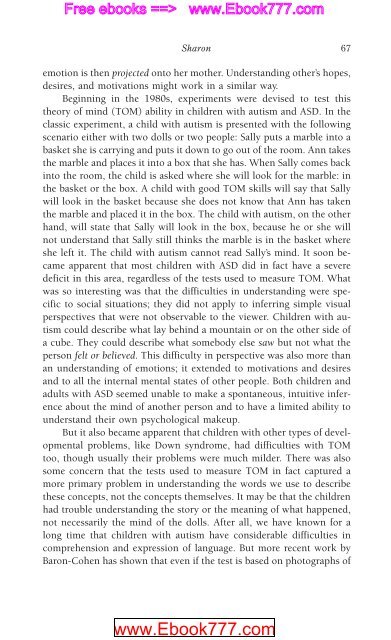978-1572305441
autism
autism
You also want an ePaper? Increase the reach of your titles
YUMPU automatically turns print PDFs into web optimized ePapers that Google loves.
Free ebooks ==> www.Ebook777.com<br />
www.Ebook777.com<br />
Sharon 67<br />
emotion is then projected onto her mother. Understanding other’s hopes,<br />
desires, and motivations might work in a similar way.<br />
Beginning in the 1980s, experiments were devised to test this<br />
theory of mind (TOM) ability in children with autism and ASD. In the<br />
classic experiment, a child with autism is presented with the following<br />
scenario either with two dolls or two people: Sally puts a marble into a<br />
basket she is carrying and puts it down to go out of the room. Ann takes<br />
the marble and places it into a box that she has. When Sally comes back<br />
into the room, the child is asked where she will look for the marble: in<br />
the basket or the box. A child with good TOM skills will say that Sally<br />
will look in the basket because she does not know that Ann has taken<br />
the marble and placed it in the box. The child with autism, on the other<br />
hand, will state that Sally will look in the box, because he or she will<br />
not understand that Sally still thinks the marble is in the basket where<br />
she left it. The child with autism cannot read Sally’s mind. It soon became<br />
apparent that most children with ASD did in fact have a severe<br />
deficit in this area, regardless of the tests used to measure TOM. What<br />
was so interesting was that the difficulties in understanding were specific<br />
to social situations; they did not apply to inferring simple visual<br />
perspectives that were not observable to the viewer. Children with autism<br />
could describe what lay behind a mountain or on the other side of<br />
a cube. They could describe what somebody else saw but not what the<br />
person felt or believed. This difficulty in perspective was also more than<br />
an understanding of emotions; it extended to motivations and desires<br />
and to all the internal mental states of other people. Both children and<br />
adults with ASD seemed unable to make a spontaneous, intuitive inference<br />
about the mind of another person and to have a limited ability to<br />
understand their own psychological makeup.<br />
But it also became apparent that children with other types of developmental<br />
problems, like Down syndrome, had difficulties with TOM<br />
too, though usually their problems were much milder. There was also<br />
some concern that the tests used to measure TOM in fact captured a<br />
more primary problem in understanding the words we use to describe<br />
these concepts, not the concepts themselves. It may be that the children<br />
had trouble understanding the story or the meaning of what happened,<br />
not necessarily the mind of the dolls. After all, we have known for a<br />
long time that children with autism have considerable difficulties in<br />
comprehension and expression of language. But more recent work by<br />
Baron-Cohen has shown that even if the test is based on photographs of



